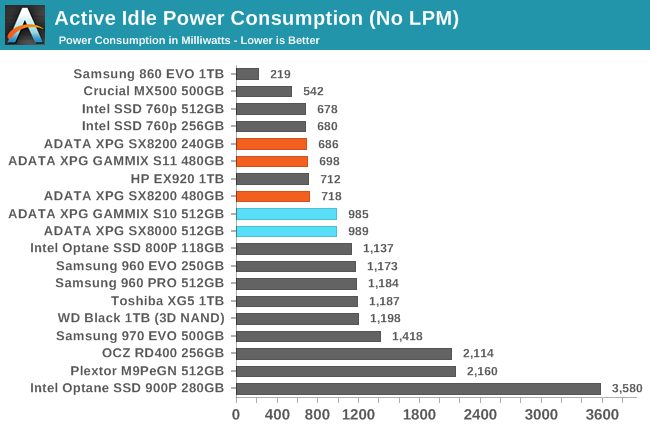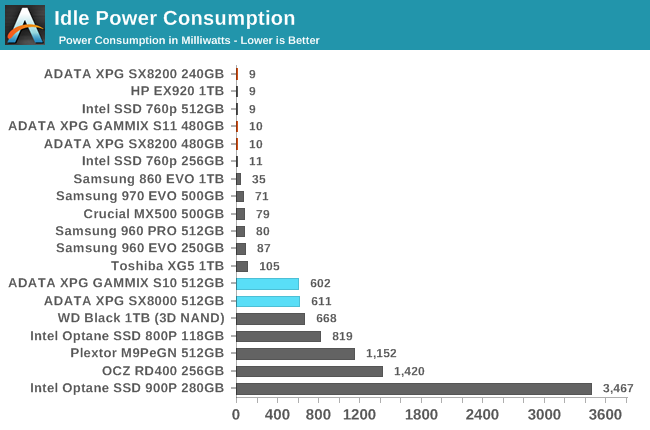The ADATA XPG SX8200 & GAMMIX S11 NVMe SSD Review: High Performance At All Sizes
by Billy Tallis on July 25, 2018 11:00 AM ESTPower Management Features
Real-world client storage workloads leave SSDs idle most of the time, so the active power measurements presented earlier in this review only account for a small part of what determines a drive's suitability for battery-powered use. Especially under light use, the power efficiency of a SSD is determined mostly be how well it can save power when idle.
For many NVMe SSDs, the closely related matter of thermal management can also be important. M.2 SSDs can concentrate a lot of power in a very small space. They may also be used in locations with high ambient temperatures and poor cooling, such as tucked under a GPU on a desktop motherboard, or in a poorly-ventilated notebook.
| ADATA XPG SX8200 and GAMMIX S11 NVMe Power and Thermal Management Features |
|||
| Controller | Silicon Motion SM2262 | ||
| Firmware | SX8200: SVN105 GAMMIX S11: SVN139B |
||
| NVMe Version |
Feature | Status | |
| 1.0 | Number of operational (active) power states | 3 | |
| 1.1 | Number of non-operational (idle) power states | 2 | |
| Autonomous Power State Transition (APST) | Supported | ||
| 1.2 | Warning Temperature | 70 °C | |
| Critical Temperature | 80 °C | ||
| 1.3 | Host Controlled Thermal Management | Supported | |
| Non-Operational Power State Permissive Mode | Not Supported | ||
Our samples of the ADATA XPG SX8200 use an older firmware revision than the GAMMIX S11 sample, but the power and thermal management features are the same between the two versions. ADATA's first generation of NVMe drives using the SM2260 controller didn't support Autonomous Power State Transitions, so in practice their idle power states would usually go completely unused. The warning and critical temperature thresholds are also 8 °C higher than on the SX8000.
The new drives with the SM2262 controller not only make the idle power states usable out of the box with most operating systems, they have significantly improved those idle power states: PS3 consumption has gone from 70mW to 45mW and the transition latencies are about an order of magnitude faster. (The SX7000/GAMMIX S10 firmware actually advertised even faster transitions, but without APST support that hardly matters.)
| ADATA XPG SX8200 and GAMMIX S11 NVMe Power States |
|||||
| Controller | Silicon Motion SM2262 | ||||
| Firmware | SX8200: SVN105 GAMMIX S11: SVN139B |
||||
| Power State |
Maximum Power |
Active/Idle | Entry Latency |
Exit Latency |
|
| PS 0 | 9 W | Active | - | - | |
| PS 1 | 4.6 W | Active | - | - | |
| PS 2 | 3.8 W | Active | - | - | |
| PS 3 | 45 mW | Idle | 2 ms | 2 ms | |
| PS 4 | 4 mW | Idle | 6 ms | 8 ms | |
Note that the above tables reflect only the information provided by the drive to the OS. The power and latency numbers are often very conservative estimates, but they are what the OS uses to determine which idle states to use and how long to wait before dropping to a deeper idle state.
Idle Power Measurement
SATA SSDs are tested with SATA link power management disabled to measure their active idle power draw, and with it enabled for the deeper idle power consumption score and the idle wake-up latency test. Our testbed, like any ordinary desktop system, cannot trigger the deepest DevSleep idle state.
Idle power management for NVMe SSDs is far more complicated than for SATA SSDs. NVMe SSDs can support several different idle power states, and through the Autonomous Power State Transition (APST) feature the operating system can set a drive's policy for when to drop down to a lower power state. There is typically a tradeoff in that lower-power states take longer to enter and wake up from, so the choice about what power states to use may differ for desktop and notebooks.
We report two idle power measurements. Active idle is representative of a typical desktop, where none of the advanced PCIe link or NVMe power saving features are enabled and the drive is immediately ready to process new commands. The idle power consumption metric is measured with PCIe Active State Power Management L1.2 state enabled and NVMe APST enabled if supported.


The active idle power consumption of the ADATA SX8200 and GAMMIX S11 is in line with other SM2262 SSDs, and about 30% lower than the SM2260-based predecessors. Thanks to the addition of NVMe APST support, the newer drives actually get to use their deepest idle states, putting them around 10mW compared to the 600+ mW used by their predecessors.

Now that deep sleep states are actually being used, it's a given that the newer ADATA drives have non-trivial wake-up latencies. The SX8200 and GAMMIX S11 are relatively slow to wake up compared to the drives that idle in the 70-100mW range instead of the 10mW we get from the SM2262. However, the new ADATA drives are about 10ms faster to wake up than the other SM2262 drives we've tested.










19 Comments
View All Comments
stanleyipkiss - Wednesday, July 25, 2018 - link
I.... I... I want one!superunknown98 - Wednesday, July 25, 2018 - link
Yeah, what is the deal with the Intel 760p? is there a firmware that fixes it?Billy Tallis - Wednesday, July 25, 2018 - link
There hasn't been a firmware update for the 760p yet: https://www.intel.com/content/www/us/en/support/ar...Rick F - Wednesday, July 25, 2018 - link
Thank you. This helped me avoid two different mistakes buying an M.2 for an Asrock x370 Taichi, All of the nonworking Adata's are on the QVL, along with the 8200 that works.The 8200 read speed is comparable to Samsung, but the write speed is about half as fast as Samsung. For the cost the 8200 is much more affordable for PCIe 3.0 nvme 1.3.
So now what to do...a few years ago, B+M M.2 Sata was pretty standard. PCIe was Samsung only and cost too much. Now M.2 is in transition and not so easy.
Think I'll sleep on it, and choose a lot of Sata space, or M.2 with a controller that hasn't gone through the wear leveling of an ssd yet...Again thanks for the heads up.
CheapSushi - Wednesday, July 25, 2018 - link
This just makes me want the Intel 900P even more. I'm hoping to have Optane drives for performance, cache and main programs & OS and just use QLC NAND drives for storage.Amandtec - Thursday, July 26, 2018 - link
How about run Fuzedrive with 2GB ramdrive, 32GB Optane, 256QLC and 4+TB HDD. Everything should kind of work out quite nicely (unless you mostly access very large files only once).deil - Thursday, July 26, 2018 - link
that's my plan, I just want to use 58 GB optane drive, and maybe 512GB mv500 SSD.Death666Angel - Thursday, July 26, 2018 - link
I guess some people, including me, want to KISS regarding their PC storage tiers. How are the failure states when it comes to the Fuzedrive implementation? Is it all just cached on the faster stuff and backed up on the normal HDD, so a drive failure "in front" isn't catastrophic? I'm personally super fine with my M.2 NVME SSD (960 Evo on sale) as an OS drive and a spinning platter for other stuff on my main PC (soon to be replaced with a M.2 SATA / NVME SSD depending on motherboard upgrades) and a whole bunch of HDDs in my file server. I don't see a scenario where I need optane like performance just yet. And for the Fuzedrive thing, see above, plus I don't need simple documents or pictures loading faster, they load just fine for my taste. :) Avoids all the potential headaches of another layer of software between me an my data.DigitalFreak - Thursday, July 26, 2018 - link
With FuzeDrive, if either drive fails, you lose all data. Similar to RAID 0.Samus - Friday, July 27, 2018 - link
Backblaze is $50 a year.